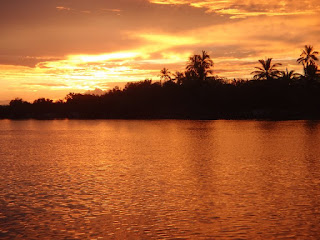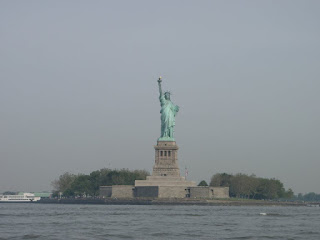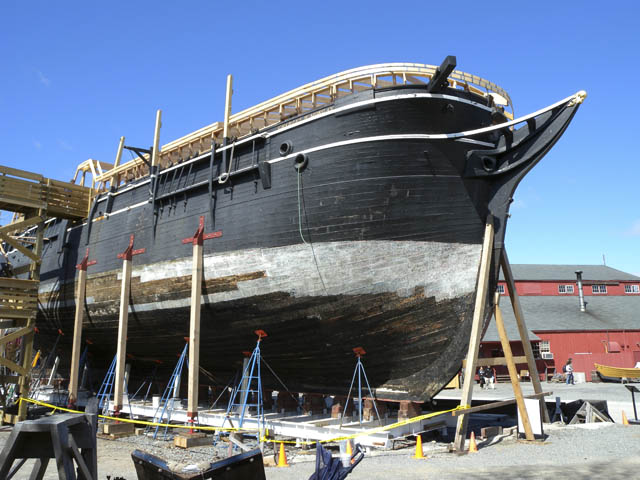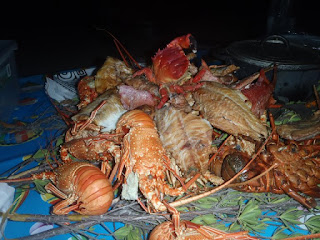 |
| Imvubu meaning Hippo going through the Northwest Passage and meeting a local. Cartoon done by Lawrence Moorcroft from the Bluff Yacht Club |
Royal Natal Yacht Club hosted Ralf Dominick recently
where he shared tales to a packed room of sailors
Going to listen to the charming Ralf Dominick, you are in
danger of acquiring a few stamps in your passport when he passionately shares
tales of his circumnavigation on his yacht Imvubu.
Commodore for the Royal Natal Yacht Club, Richard Crockett, introduced
the intrepid traveller as a free spirit, setting sail with no real plan of
where he was going.
 |
| Manihi Atoll |
Dominick stood before us smiling, explaining, “I am going
to leave out the tropics as many of you here this evening have sailed in parts
of it and a number of you here have sailed in company with Imvubu so you would
know if I am exaggerating or lying.”
Continuing with a twinkle in his eye, he commented, “I am
going to concentrate on the journey through the Northwest Passage, and it is
not because I am boasting being one of only about 150 transits through this
passage, but because no one here will know if I am exaggerating slightly.”
Dominick launched Imvubu on the 19 June 2009 at the Bluff
Yacht Club, he chuckles, “I got my own back at the truck drivers. I blocked the
road for half a day as she was craned from the yard onto a truck and
transported to the launch site.”
Departing Durban on 2 January 2010, he sailed south to
Cape Town where he packed up his boat with supplies for heading across the
Atlantic. Waving goodbye to family, he left Cape Town on 21 February 2010.
Having spent close on a year cruising through the
magnificent Caribbean islands, with Imvubu spending three months on the hard
staying safe during the hurricane season, Dominick headed north. At the end of
April they made their way up the East coast of America with the goal of making it
through the magical Northwest Passage.
They stopped in at Washington DC, sailing right into the heart of the capital.
Exploring the cultural melting pot that is the capital, Dominick stumbled upon
the Rolling Thunder Rally that has a quarter of a million Harley Davidsons
cruising through the capital. “After three hours, after watching thousands of
HOGs go by, I left, mainly because I had a headache from the noise!”

Next was a stop in New York City, “Since 9/11 I found the
residents to be a lot kinder than in previous visits.” he stated happily.
“One of the best naval museums I have ever visited was
located at my next stop, in Mystic Seaport located on the Mystic River. They
have over 35 boats on display including an 1820 whaling ship. The Charles W.
Morgan is the only surviving wooden whaling ship in America. It was a treat to
visit.”
At Portland, on the coast of Maine, gearing up for the
expected freezing conditions further north, another 20,000BTU of heating was
added to the 5,500BTU already installed on Imvubu.
From the USA East Coast the journey continued on to Nova
Scotia, Canada and onwards to Newfoundland. “A number of the small towns are
slowly dying due to the moratorium on Cod fishing. In fact during the 1950’s
the government had a forced resettlement program to consolidate many of these
settlement. Most adults now work on the oil fields in Alberta while the youth
are moving south where life is a lot easier, so in some places it felt like a
ghost town.”
“I sailed through a fjord that was 200m wide and was
experiencing the worst fog for many years. In the gaps we managed to see the
sheer cliffs that surrounded us with tumbling waterfalls cascading into the
cold water. Yet another exquisite memory!”
 |
| Ralf's favourite pic of an Iceberg. He didn't dare get to near it in-case he dislodged some of the ice. |
While in Newfoundland Dominick made the decision to commit himself and his crew to the Northwest Passage: “I must say, it was the case of right place, right time, right boat and the crew was solid!”
 |
| Newfounland Huge Fjord |
In 1497, the first recorded expedition to find the
mythical Northwest Passage, was undertaken by John Cabot. For the next three
centuries there were many expeditions to locate this passage. During the
Napoleonic wars the quest for the passage waned. However in 1819, due to
reports by whalers that the ice was retreating, interest in finding the passage
was renewed. The most famous failure was in 1845 when Sir John Franklin, with
his two vessels the Terror and the Erebus, failed to return. Subsequent relief
expeditions, launched at the behest of Lady Franklin to determine the fate of
John Franklin, are credited with having discovered an impractical ice bound
passage by dog sled. John Rae, an employee of the Hudson Bay Company, while on
a dog sled expedition in this area is now generally credited with having
discovered a navigable passage through the Franklin Strait into the Beaufort
Sea.
The first vessel to actually transit the North West from
Arctic Circle to Arctic Circle was Roald Amundsen in 1903. The next transit was
some forty years later by a Canadian Police cutter skippered by Henry Larsen.
By the end of the 2010 season the Scott Polar Research Institute at University
of Cambridge had recorded 143 transits by 99 different vessel.
Dominick was approximately the 150th entry into the
esteemed list that completed a transit from Arctic Circle to Arctic Circle
through the Northwest Passage. Imvubu was the first South African Vessel to
have completed the transit.
In 2011, the window of opportunity was better than
previous years as the temperatures and ice seemed a lot kinder than in previous
years, giving Imvubu and Dominick a gap of six weeks to make it through.
Dominick stopped off at St John, Newfoundland, the last
significant town before getting to the other side of the world, to prepare the
vessel for what lay ahead. “There are many details to be considered such
as a solution for preventing the engine cooling water intakes from freezing,
preventing condensation from forming on windows, provisions for a year and of
course charts for the region.”
“You might have heard of St John, the wreck of the
Titanic lies some 600km south east of this town. The distress call from the
Titanic was picked up at Cape Race,
140km south of St John's, where the Canadian Marconi company had built a
station eight years earlier.”
“Before departing St John, I went to collect our charts
that I had ordered but they hadn’t arrived. The charts were a vital ingredient
for the next leg. We needed the charts! The owner of the company promised me
that at the next stop at Cartwright in Labrador, he would have the charts
there; they would be at the small airport. We got to the airport a few days
later and went to meet the plane, but there was nothing. The pilot defensively
even suggested we search the plane, there really were no charts. I contacted
the airline and found that the plane that they were on had been diverted due to
the weather. So asking around I found a lady who lived in the town where the
plane was and her brother was unemployed, so he got in the car and drove the
charts up, a return trip of 16 hours. Arriving at 1am, we gave him a cup of
coffee, a thousand dollars and then sent him on his way a few hours later.”
The plan was to sail 2,000 miles northwards before
turning westwards into Lancaster Sound, which marks the start of the actual
passage. A 100 miles south of the turning point they sailed past a tender
floating upside down. “It didn’t sit right as it clearly belonged to a yacht
and there weren’t too many yachts around so we pulled it on board and contacted
the coast guard. “The coastguard requested that we divert to Pond Inlet, a
small hamlet in the high Arctic, to deliver the salvaged tender so that they
could investigate its origins”.
Meeting the Coast Guard, meant that the planed route
altered slightly with a dogleg down to Pond Inlet, the coast guard on the
other hand made sure that there was sufficient diesel fuel available for
Imvubu.
On 20 August the direction altered for the first time in
ten days, with Imvubu now following a path in a westerly direction. On 24
August, the South African vessel reached her highest point north, with the
co-ordinates of 74°19’N, the wind was averaging 40knots and the temperature was
2.5°C.
They turned down to Cambridge Bay where they anchored to
refuel. While they were ancored in the bay, Eskimos were shooting at Narwhals,
small whales with a single tusk or the mystical unicorn whales. “It was a
surreal Wild West situation, after refuelling with 500 litres of jet fuel, the
only fuel they had in Cambridge Bay we were at anchor and had bullets whistling
past us. It didn’t look like the locals were effective hunters as the bullets
were almost hitting us and not the whales!”

The next encounter Dominick had with the locals was at
the next settlement of Tuktoyaktuk as a guest at the local school, “I was
invited to the school when the new teaches were being introduced. On one of the
walls there was a huge sign in English advertising that they should eat more
whales because they were good for you! The sign went into great details,
talking about the fat content and what it did for you! Fascinating reading.”
Continuing, “This is where I tried whale blubber; I have to admit it wasn’t
very tasty. Somewhat how one would imagine it to taste like!”, “a local Inuit
hunter however gave me two freshly bagged brown speckled geese, that made a
superb potjie”.
The door started slamming on the adventurer, with the
pack ice moving in. He made his way through the Bering Strait sailing between
Russia and across the way, the tip of America, leaving behind the Arctic
Circle. He made it to Nome, Alaska surfing in in early September, 164
miles from Siberia and just under 2,000miles from the North Pole. Nome is
renowned for gold mining and Dominick met a man who generously gave him two
nuggets as mementos from Alaska.
 |
| A sign post in Nome, Alaska |
“I read in the Nome Times that when the cartographer was
mapping the area, they hadn’t named the Cape so he simply wrote ‘? name’ down
on the map. When the maps got back to the United Kingdom, the chap officially
drawing them up read it as C. Nome which promptly became Cape Nome and the name
stuck and that is how it has stayed!”
“Crossing the Bering sea we got hammered although it
could have been much worse and made it into the safety of False Pass in the
Aleutian Islands with hours to spare before the next big storm system arrived”.
When the weather cleared Imvubu pushed on, passing
steaming volcanoes, “There are 36 active volcanoes in Alaska, the most anywhere
in the world located in one country! As we were sailing on a relatively calm
day through the Kupreanof Straits a rocket launch took place from the Kodiak
Space Centre on the other side of Kodiak Island”.
The intrepid traveller sat out yet more bad weather in
Yakutat Bay on the eastern side of the Gulf of Alaska, here he joined another
yacht that had also transited the North West Passage and the two of them waited
through gale force winds. “We followed a number of fishing vessels heading out
but encountered an unexpected low pressure system with storm force winds and
mountainous seas, clearly we didn’t go very far and turned around and ran for
shelter.”
“In desperation I spoke to the met guys and their
response was that they were unable to forecast the weather because every few
hours the weather was changing dramatically.”
In the early hours of the next morning there was a slight
break in the weather and Dominick decided this was the gap. Saying a quick
goodbye to this fellow yachtsman, who was not at all convinced that there was a
break, he left the dock and sailed further down the coast, escaping the weather
in a few more coves but made it into the safety of the Alaskan Inside Passage.
“When I arrived at Juneau Alaska I could celebrate as I
had made it through the Northwest Passage and got out of the high latitudes
before winter set in! Although I was now through the worst I knew there
was still a hard slog ahead to make my way down the North American west coast
in winter.”
“My friend got stuck in Yakutat for a further three weeks
and by the time he got into the Inside Passage the season was too far advanced
and he had to give up and spend the winter at Sitka.”
Showing us a number of gorgeous images, he pauses
stating, “Of the thousands of photos that I took on the trip, this is my
favourite. Blackstone Glacier was just exquisite.”
Asked if he was ever scared, he smiles, “I used to fly
jets for fifteen years so going from a sport of flying at a speed of six miles
a minute to sailing six miles an hour, I would think I coped under the
pressures that arose. And I have to say that the boat was superb in all the
conditions!”
Concluding he questions, “Doesn’t anyone want to know
about the fishing and the fish? The places I visited were not only picturesque
but heavenly on the taste buds. I ate like royalty, everything from crayfish to
salmon to cod. You name it, I sampled it. I would have to say my best fish
would have to be Arctic Char which was just delectable.”
Imvubu is currently being prepared for her next odyssey
when he plans to head down south to Antarctica and then up the east coast of
South America before crossing to Europe However, he is plotting to return to
Alaska… in summer and not with his boat.
The inspiring story of Ralf Dominick’s lifelong
dream to circumnavigate the globe plants seeds for those with itchy feet and a
desire to travel to a number of incredible options that lie waiting to be
discovered.























